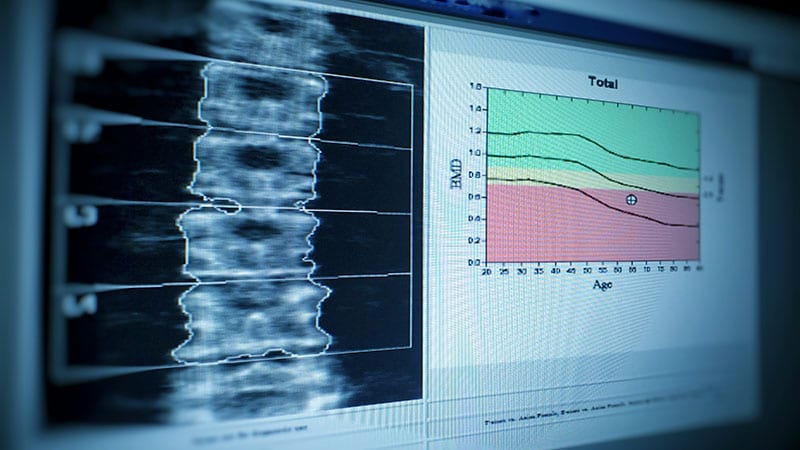[ad_1]
TOPLINE:
Romosozumab for 12 months followed by alendronate for 24 months leads to greater improvements in lumbar spine bone density and trabecular bone scores than alendronate alone for 36 months in postmenopausal women with type 2 diabetes (T2D) and osteoporosis.
METHODOLOGY:
- Lower trabecular bone scores, which are associated with increased fracture risk, have been reported in patients with T2D.
- Researchers conducted a post hoc analysis of the Active-Controlled Fracture Study in Postmenopausal Women With Osteoporosis at High Risk (ARCH) trial to examine the effect of romosozumab followed by alendronate vs alendronate alone on bone strength parameters in a subgroup of participants with diabetes at baseline.
- Participants in ARCH were randomized to receive either monthly 210 mg romosozumab for 12 months followed by weekly 70 mg alendronate for 24 months or weekly 70 mg alendronate alone for 36 months.
- Lumbar spine areal bone mineral density and tissue thickness-adjusted trabecular bone score were evaluated using dual-energy x-ray absorptiometry scans at baseline and 12, 24, and 36 months postoperatively.
TAKEAWAY:
- Of 360 postmenopausal women included in this analysis (99.2% with T2D), 165 (mean age, 75.7 years) received romosozumab-to-alendronate and 195 (mean age, 75.2 years) received alendronate alone.
- At month 12, romosozumab followed by alendronate led to significantly greater gains in lumbar spine areal bone mineral density (least squares mean difference [LSMD], 7.0%; P P
- These benefits were maintained even after the patients transitioned to alendronate, showing significant persistence at 24 and 36 months compared with alendronate alone.
- The percentage of women with normal trabecular bone score values increased from 23.6% at baseline to 50.0% at month 36 in the romosozumab-to-alendronate group, compared with an increase from 25.1% to 38.0% in the alendronate-alone group.
- Percentage changes from baseline in tissue thickness-adjusted trabecular bone score poorly correlated with those in lumbar spine areal bone mineral density, with correlations remaining low in both the groups throughout the treatment period.
IN PRACTICE:
“The greater and more rapid increases in [areal bone mineral density] and [tissue thickness– adjusted trabecular bone score] that we observed with romosozumab followed by alendronate compared with alendronate alone may contribute to a greater reduction in fracture risk in patients at high risk for fracture, such as postmenopausal patients with diabetes,” the authors wrote.
SOURCE:
This study was led by Serge Ferrari, MD, Geneva University Hospital, Geneva, Switzerland, and published online in The Journal of Clinical Endocrinology & Metabolism.
LIMITATIONS:
This analysis was conducted in only 8.8% of the overall population of ARCH, which could have led to potential imbalances in covariates between treatment groups. Proactive assessments for diagnosing diabetes were not performed, and information on the use of antidiabetic medications were not collected. Longitudinal data were limited to a median follow-up duration of 2.7 years, with fewer than half the patients having lumbar spine measurements at month 36.
DISCLOSURES:
This study was funded by Amgen, UCB Pharma, and Astellas Pharma. Four authors reported receiving grants, research support, or consulting fees and holding other ties with Amgen, UCB Pharma, AgNovos, and other pharmaceutical companies. Four authors declared being current or former employees and holding stocks of Amgen or UCB Pharma.
This article was created using several editorial tools, including AI, as part of the process. Human editors reviewed this content before publication.
[ad_2]
Source link : https://www.medscape.com/viewarticle/romosozumab-improves-bone-strength-women-t2d-2025a100034s?src=rss
Author :
Publish date : 2025-02-07 12:53:08
Copyright for syndicated content belongs to the linked Source.
